
* The Mosquito entered RAF service towards the end of 1941, but production remained limited through 1942, while the brass and the aircrews figured out what should be done with the fast new machine. By the beginning of 1943, the Mosquito was beginning to become available in large numbers and the Germans were learning to hate it thoroughly. It remained one of the Luftwaffe's major headaches for the rest of the war.
This chapter outlines the Mosquito's combat service with the RAF in World War II, its postwar service, and foreign production and operation.
* As mentioned earlier, the Mosquito performed its first sortie in September 1941. On 18 September, Squadron Leader Rupert Clerke and his observer, Sergeant Sowerbutts, of the RAF Number 1 PRU took off in a Mosquito PR.I on a mission to Southern France. Intelligence suggested that the Nazis were massing troops to occupy Spain, and the Mosquito was to check it out. However, the aircraft's electrical generator failed and the batteries ran down, rendering the cameras so much dead weight; the Mosquito had to return to base. In some compensation, the aircraft was jumped by three Messerschmitt Bf 109s but easily outran them, no doubt leaving behind very startled Luftwaffe pilots wondering what the hell they had been chasing.
The same Mosquito performed another reconnaissance mission over Southern France two days later, on 20 September, with Flight Lieutenant Alistair Taylor at the controls. The mission was successful, and from that time on Number 1 PRU's began to range widely over Western Europe. Unfortunately, Taylor and his Mosquito were lost ten weeks later, shot down by German flak during a mission against Trondheim and Bergen, Norway. It was the Mosquito's first combat loss.
* A total of 20 Mosquitos was completed by the end of 1941. While reconnaissance machines were the immediate priority, some Mosquito bomber and night-fighter variants were delivered to RAF frontline squadrons during the winter of 1941:42, but foul weather kept them from seeing much combat during that time. The first Mosquito bomb raid was on 31 May 1942, as a follow-up to the first RAF "thousand bomber raid", performed on Cologne the night before. Five B.IVs were sent in singly to hit Cologne from altitude during the day to keep the Germans off-balance.
It wasn't a very good use of the machine, and one was shot down by flak, allowing the Germans to examine the wreckage. Ironically, the existence of the Mosquito remained an official secret for some time after that, with one British newspaper called to task by the authorities for mentioning it.
Bomber Command didn't really know what to do with the Mosquito and remained unenthusiastic about it, all the more so because subsequent bombing missions with the machine produced lower-than-average results and higher-than-average losses. The German Focke-Wulf Fw 190 proved able to perform a dive from altitude and "creep up" on the Mosquito, with crews unable to do anything but pray since they had no way to shoot back. The Soviets had developed an "aerial mine", a small fragmentation bomb on a parachute, to deal with tail chases and apparently it was effective, but the British never adopted such a weapon. Gradually, various engineering refinements, such as the jet-boost exhausts and improved engines, increased the gap between the Mosquito and the Fw 190. Pilots also learned they could shake the Fw 190 by going into a shallow dive and performing a corkscrew maneuver, since the Focke-Wulf's controls tended to "freeze up" at high speeds more quickly than those of the Mosquito.
There was another reason for the indifferent attitude towards the Mosquito bomber. At the time, under Air Marshall Sir Arthur "Bomber" Harris, Bomber Command was focused on indiscriminately plastering German cities, which required heavy bombers such as the Avro Lancaster and the Handley-Page Halifax. Geoffrey de Havilland JR's younger brother, Major Hereward de Havilland, wrote Hatfield in the fall of 1942: "Lunched at Bomber Command with Air Commodore Harrison. Harrison is the only person I have met at Bomber Command who has any enthusiasm for the Mosquito. The C-in-C certainly has none ... "
Even as Hereward de Havilland was writing this, however, the situation was finally beginning to turn around. Pilots in Bomber Command Number 105 and Number 109 Squadrons decided that the Mosquito was best suited to low-level precision bombing, and were operationally experimenting with the technique.
There were some bugs to be worked out of the concept. On a mission against a Dutch target, for example, a Mosquito ran into a flock of curlews, one of which smashed through the windscreen and knocked out the pilot. The navigator managed to grab the yoke and pull it back just in time to keep from plowing up the ground. The pilot came to, but he was blinded by blood and the wind was howling into the shattered windscreen. The navigator managed to get them back home by crawling forward into the nose and directing the pilot with soft kicks to the shins. Bomber Mosquitos quickly acquired strengthened windscreens to deal with birdstrikes.
Results were not immediately forthcoming, either. On 19 September, the Mosquito made its first attack on Berlin. Six B.IVs performed the attack, or at least tried to, since Berlin was so socked in by the weather that only one of the attackers managed to drop bombs on the target. The others either bombed Hamburg, the alternate target, or jettisoned their warloads. One Mosquito didn't come home.
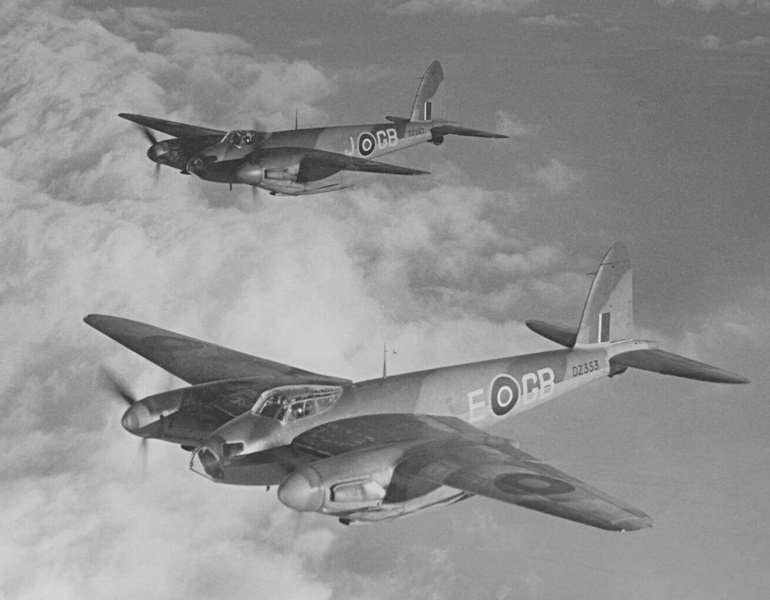
The first break was on 25 September. Vidkun Quisling, a prominent Norwegian stooge of the Nazis and a high-profile target of Allied propaganda, was to give a rally at the Gestapo headquarters in Oslo that day, and four B.IVs of Number 105 Squadron were assigned to break up the party. The building was hit by four bombs, three of which detonated; one Mosquito was shot down by Fw 190s. The mission was successful, if expensive. The Mosquito was still suspect in Bomber Command, but it was now on the road up. The Mosquito was finally announced to the British public on 26 September 1942 along with the news about the successful raid on the Gestapo headquarters in Oslo. By this time, the Germans were thoroughly familiar with the machine and it was certainly no secret to them.
* Although night-fighter Mosquitos were a high priority and the RAF had NF.IIs in service by early 1942, they didn't score a "kill" for months. Heavy Luftwaffe night raids on Britain had dried up, since Hitler had shifted the weight of the Luftwaffe east for the invasion of the USSR in the spring of 1941.
Not only were targets hard to come by, but getting the Mosquitos up to full working condition proved difficult. The hasty introduction of muzzle flash suppressors was mentioned earlier; the engine exhaust shrouds cut down the machine's speed and wore out quickly. The initial velvet-black finish cut down the machine's speed as well, forcing a switch to matte-black paint. Crews definitely needed more training in night operations, with a number of aircraft lost in accidents.
Problems were worked out, the crews grew more confident, and they still had a few targets, since the Luftwaffe continued to perform small nuisance raids on Britain. These raids focused on targets of historic or cultural importance and were therefore called "Baedeker raids", in reference to popular travel books of the era. Number 151 Squadron may have scored the Mosquito's first "kill" in the dark hours of the morning on 30 May 1942, claiming a Heinkel He 111 on the night of 29 May, but the kill was not confirmed. Number 157 Squadron competitively claimed damage to a Dornier Do 217 the next night.
Number 151 Squadron scored the first confirmed kills on the night of 24 June, when an NF.II shot down an He 111 and a Do 217 within ten minutes of each other. More kills were claimed over the following months, though they came in at a slow rate.
Initial successes revealed another problem with the Mosquito. Night fighters generally had to come to close quarters on their opponents, which often blew up under attack. The radiators in the wing leading edge tended to be vulnerable to damage under such circumstances, and it was not unusual for a night fighter to come back to base on a single engine. Although experiments were made with different radiator fits, they cut down the aircraft's performance too much to be worthwhile; the problem was never really fixed.
Night-intruder sorties against Luftwaffe training fields in Northern France began in July 1942, as part of a general campaign of day and night "fighter sweeps" begun in late 1941, designed to give the RAF more combat experience and the Germans more headaches. The NF.II Specials were stripped of AI radar so that its secrets would not fall into German hands, but Mosquito pilots were able to jump Luftwaffe aircraft flying lit up with their landing and navigation lights on. The intruders made the Germans so jumpy that in at least one case a pilot simply flew into the ground while being pursued by a Mosquito. The intruders soon forced the Luftwaffe to move the training squadrons back to Germany.
* By fall, the Mosquito was also performing meteorological reconnaissance flights over occupied Europe, plotting the weather to support bombing raids and other military activities. Bomber Command was still leery of the Mosquito, but the rest of the RAF was increasingly appreciating the machine's capabilities and was in fierce competition for the slowly rising trickle of production.
BACK_TO_TOP* Aircrews had liked the Mosquito from the start. There were initial teething problems, but such were to be expected with a new machine, and they didn't disguise the fact that the DH.98 was fast and agile. A lightly-loaded Mosquito performed so well even with an engine out that pilots said DH had designed it as a single-engine aircraft, and added a second engine for good luck. According to one tale, later in the war an incautious Yank pilot at the controls of a Martin B-26 Marauder, itself regarded as a fairly hot twin-engine aircraft, once challenged a Mosquito pilot to a race. The Mosquito left the B-26 in the dust, flying past inverted with one prop feathered.
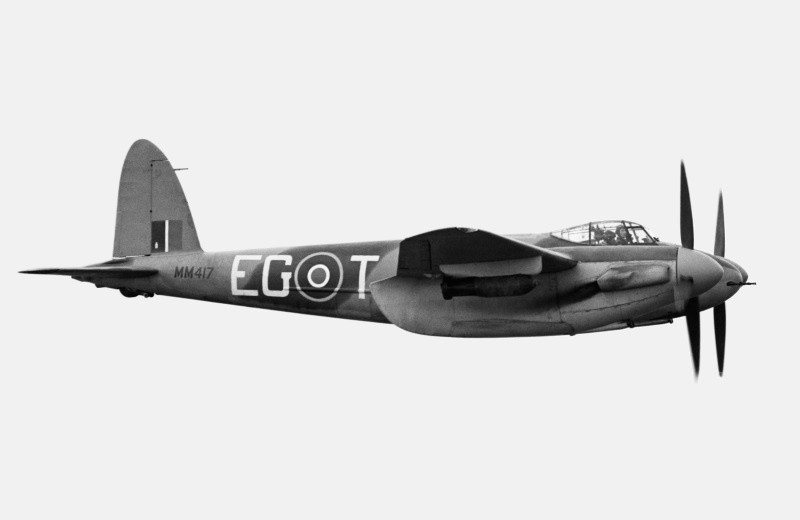
However, since it was a hot aircraft, the Mosquito was not perfectly friendly. It was by no means a beast, it just had a lot of performance and the pilot had to be aware of what he had his hands on. Its high wing loading gave it a relatively smooth low-level ride, at the expense of hot landings. Its agility allowed a ham-fisted pilot to tear the wings off in aggressive maneuvers. It was touchy in pitch trim, with bomber variants tending to be tailheavy and fighter variants tending to be noseheavy. One of the worst problems was that getting into and, more significantly, out of a Mosquito was something of a chore. The bottom hatch in the bomber and reconnaissance versions and the side door in the fighter versions were a tight fit, particularly for aircrew in flight gear and parachute. Most aircrew liked an aircraft that was easy to get out of in a hurry should the thing decide it didn't want to go on flying any longer.
Ground crews were suspicious of it at first because of its unusual construction, but gradually came to appreciate that it was a sturdy and reliable machine. The Mosquito became known as the "Wooden Wonder", less respectfully the "Termite's Dream", or just generally the "Mozzie".
BACK_TO_TOP* If the Mosquito was having a hard time proving itself as a bomber, nobody had the slightest misgivings over it as a reconnaissance aircraft -- it could go wherever it pleased, and there wasn't much the Germans could do about it. Number 1 PRU was finding itself much needed and correspondingly heavily taxed, and was effectively upgraded from a squadron to a wing in October 1942 by being split into five squadrons.
One of the squadrons, Number 540, was equipped with the Mosquito, which was preferred for long-range missions into hostile airspace over reconnaissance Spitfires, which simply didn't have the reach. The PR Mosquitos ranged all over Europe and returned with spectacular images that provided useful military intelligence as well as some propaganda value. Crisp photographs of major targets, such as the German battle cruiser GNEISENAU, were released to the press to demonstrate that RAF aircraft could fly anywhere over the Reich with apparent impunity.
Since the PR Mosquitos operated mostly by day and by themselves, they had the greatest need for speed and height, and were given priority for the Mosquitos with two-stage Merlins, beginning with the PR.VIII. They were re-equipped with the improved machines through 1943, and the PR.Is and PR.IVs were all retired by October 1943.
A PR.VIII became the first Mosquito to photograph Berlin, on 8 March 1943. On 2 June 1943 a PR.VIII overflew the German technical research center at Peenemunde on the Baltic coast. Previous missions there had turned up nothing, but this flight brought back images of the new German V-2 long-range ballistic missile. The installation was heavily bombed by the RAF in August under Operation HYDRA.
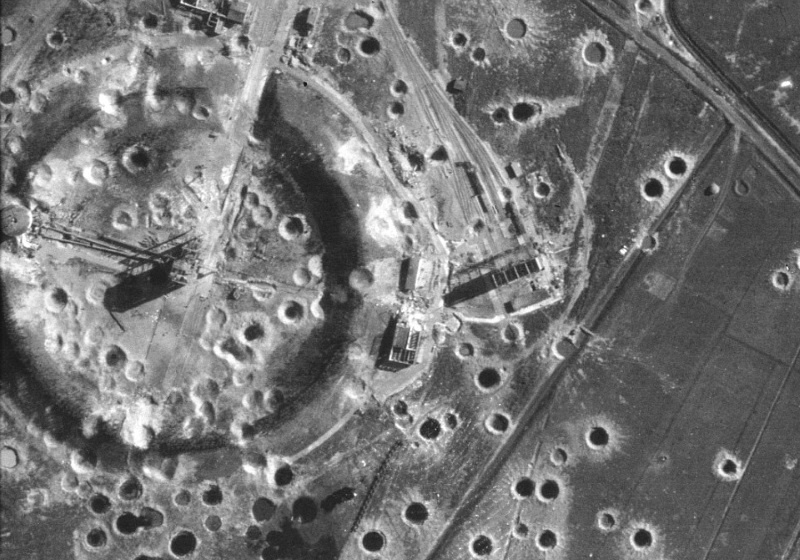
The PR.IX's more powerful engines and greater fuel load were put to good use. During 1943, one made a "grand tour" of Central Europe, flying out of RAF Benson and overflying Regensburg, Germany; Vienna, Austria; Budapest, Hungary; and Foggia, Italy, before landing in Catania, Sicily. The trip covered 3,060 kilometers (1,900 miles), took 6 hours 30 minutes flying time, with an average speed of 407 KPH (292 MPH). The Mosquito ran out of gas before it could taxi to its parking spot.
In the winter of 1943:1944, PRU Mosquitos began to reach for higher altitude in order to evade improved defenses. That led to the eight PR.IXs modified with uprated Merlins and four-bladed propellers, but the height and cold were hell on both crews and aircraft. The pressurized PR.XVI was designed in response, though various teething problems kept it out of service until May 1944.
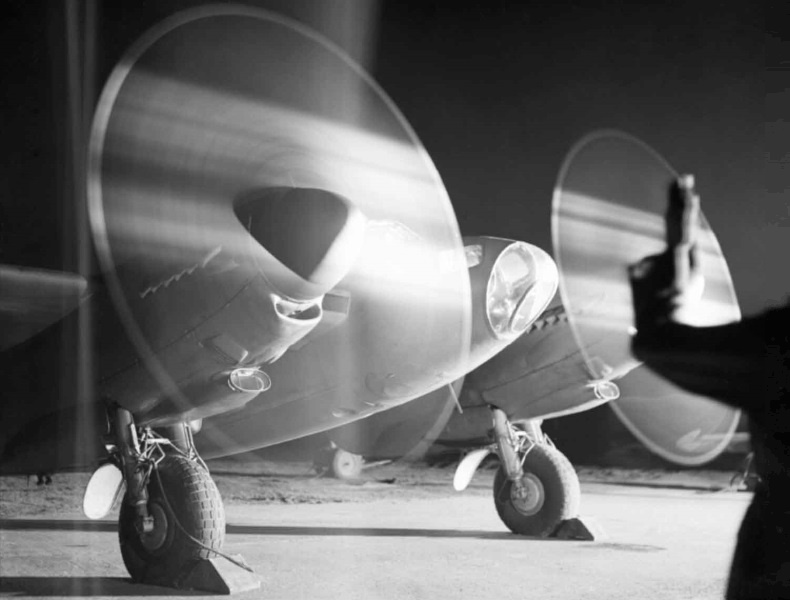
The handful of long-winged PR.32s were up to the task, but by the time they got into service, there wasn't much of a task left, at least in Europe. This was fortunate for the PRU, since by late 1944 the Mosquito was beginning to encounter the Messerschmitt Me 262 jet fighter, which could easily outrun even the quick Mosquito. Fortunately for the Allies, the Me 262 was too little and too late, with most of those produced usually grounded for lack of fuel.
Mosquitos were first sent to the Far East in the spring of 1943, performing reconnaissance sorties from Calcutta over Southeast Asia. The ultimate reconnaissance Mosquito, the PR.34, began flying out of the Cocos Islands, in the Indian Ocean south of Sumatra, in July 1944 to overfly Japanese installations in Southeast Asia.
BACK_TO_TOP* By early 1943, even Bomber Command was beginning to warm to the Mosquito. Attrition was still high, the rate being about 8% of sorties compared to about 5% for the "heavies", but the loss rate was slowly declining. In compensation, the Mosquito was proving extremely useful for precision bombing. Number 105 and Number 139 Squadrons had refined their low-level attack techniques. A first wave would zoom in, dropping bombs with 11-second delay fuzes, to be followed by a second wave performing a shallow dive attack with instantaneous fuzes.
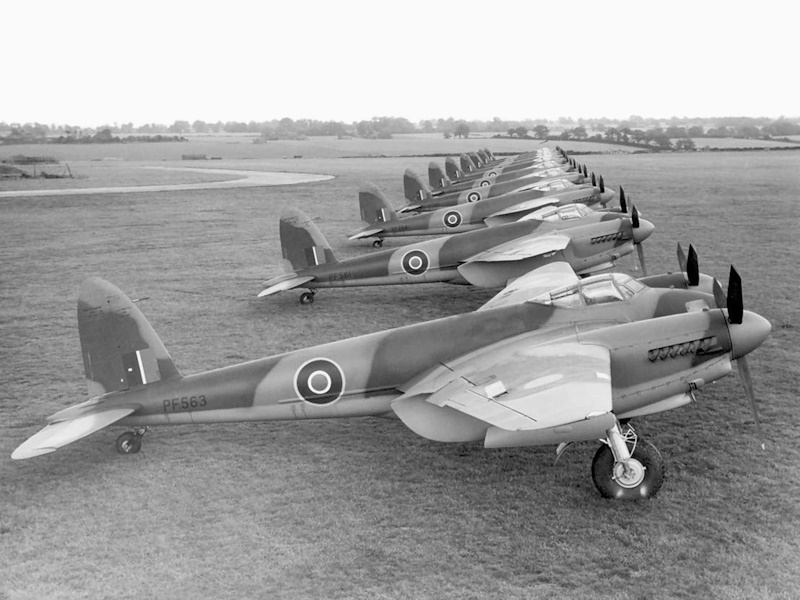
105 Squadron paid their first visit to Berlin on 31 January 1943, with the attack timed to interrupt a parade being addressed by Reichsmarshal Hermann Goering. Later on the same day, Number 139 Squadron B.IVs similarly disrupted a rally being addressed by Reich Propaganda Minister Joseph Goebbels. These two nuisance raids made for good propaganda, and in the meantime the Mosquitos were also inflicting real damage on certain high priority targets.
Major Hereford de Havilland was able to write his brother: "Air Marshall Harris told me that he had, quite frankly, been surprised at the success Mosquitos had had on low-level attacks, and he said as much in a letter he addressed to the units concerned." However, Bomber Harris still had his priorities. The letter continued: "But he still considers that only a very small force should be diverted from the normal bombing routine for this type of work. For Pathfinding, which, he stated, will become the most important of all duties, the Mosquito is indispensable."
Harris reassigned his Mosquitos to the Pathfinder role, marking targets for heavy bomber strikes. Despite that, the RAF barely skipped a beat on low-level strikes with the Mosquito, the technique being quickly picked up by RAF tactical support squadrons, as discussed below.
The B.IV was absorbed into RAF 8 Group, the "Pathfinder Force (PFF)", which was set up in July 1942, and fitted with electronic navigation aids. The British had already put the "Gee" navigation system into service in the spring of 1942, which picked up signals from radio beacons in Britain and gave the aircraft's position by a scheme similar to triangulation. Gee was inaccurate for targeting purposes, and by the time the B.IV was being put into service as a pathfinder, the Germans were jamming it anyway. Gee did stay in service as a navigation aid, and Gee receivers were fitted to some variants of Mosquitos.
Pathfinder Mosquitos were initially fitted with another navigation system, named "Oboe". This involved two radars set up in Britain, one named "Cat" that tracked the pathfinder along a constant-range path, the other named "Mouse" that determined when it was over the target. The system was called "Oboe" because the aircraft stayed on its constant range path using a tone fed into the pilot's headphones; the tone was broken into "dots" if the bomber was too far out, into "dashes" if the bomber was too far in, and produced a continuous tone if the bomber was on track. Oboe was almost as accurate as clear-daylight bombing, though it was limited to line-of-sight operation. This at least put it in range of the Ruhr Valley, Germany's industrial heartland, and PFF Mosquitos fitted with Oboe kicked off the "Battle of the Ruhr" in March 1943, marking Essen for a raid by the heavies. The original Oboe was a longwave radar system and by the time the Germans got wise to it in the summer of 1943 and set out to jam it, the British had already moved to a centimetric system, though they continued to transmit the longwave signals as a deception.
For targets beyond the range of Oboe, PFF Mosquitos were fitted with a British centimetric targeting radar, known as "H2S"; the meaning of the acronym is now unclear. Pathfinder Mosquitos were modified to carry H2S using a radome under the rear fuselage, though some experimental fits had the radome under the forward fuselage. H2S gave a very rough and ambiguous radar map of a target and could only clearly recognize targets identified by distinctive bodies of water -- but it was better than nothing. It went into service in July 1943.
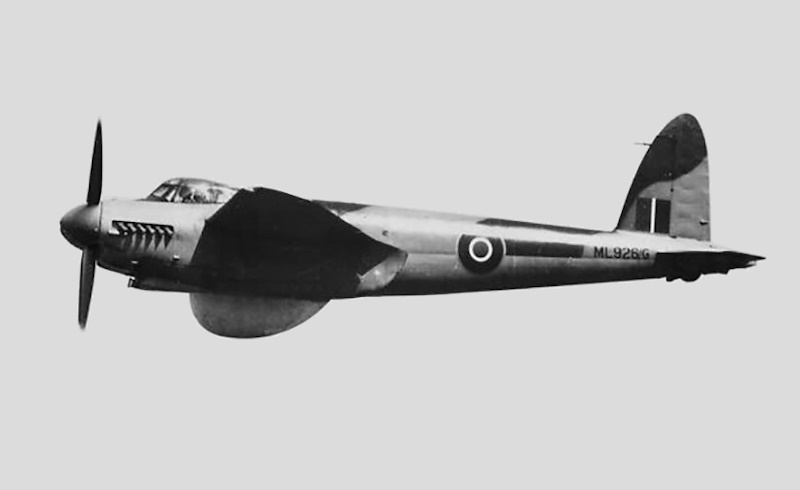
* Although the PFF used the Mosquito B.IV and the new B.IX to mark targets for heavies, the group also used it as the basis for what became the "Light Night Striking Force (LNSF)", sometimes called the "Fast Night Striking Force", which started out by performing diversions for heavy-bomber raids, dropping markers and a few bombs on a "fake" target to distract the defense, then tossing out aluminum strips called "Window" (chaff) to jam German radars.
Gradually, as more bomber Mosquitos fitted with the oversized bomb bay doors to carry Cookie bombs came into service, the LNSF's "diversionary" raids turned into effective attacks of their own. The B.IV didn't really have the horsepower to carry the Cookie well, but the B.IX and the B.XVI, with two-stage engines, were reasonably comfortable with the load. The B.XVI, built standard to carry the Cookie, entered service in early 1944, at about the same time that the LNSF started dropping Cookies on the Germans in earnest.
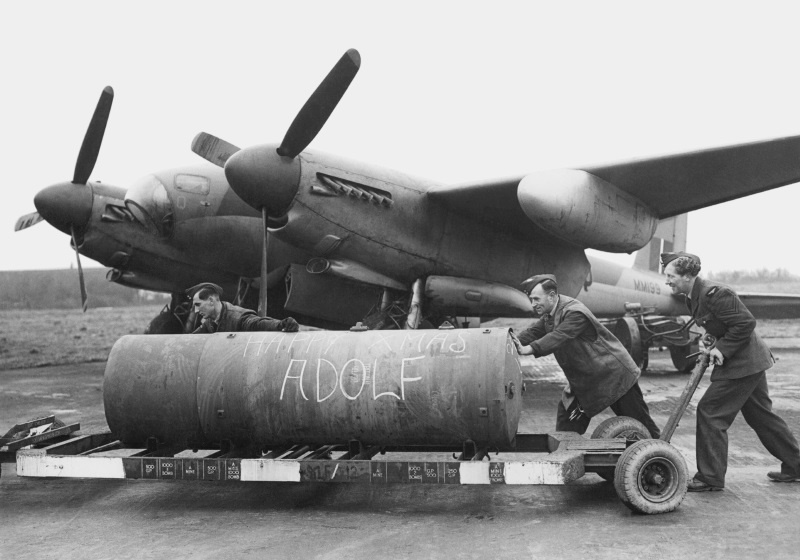
The B.XVIs became very energetic in the late stages of the war, in particular performing about 170 strikes on Berlin, reaching a peak on the night of 21 March 1945, when a total of 142 Mosquitos hit the city in two attacks. The crews hit Berlin so often they called it the trip the "Berlin Express".
During the Battle of the Bulge in December 1944, Bomber Command B.XVIs performed an interesting variation on the low-level attack, attempting to toss Cookies into railroad tunnels. This was dicey and not completely successful, though at least one tunnel was caved in using the trick. The LNSF also laid mines in German ports and canals. The last Bomber Command raid of the war was performed by 16 Mosquito B.XVIs of Number 608 Squadron on Kiel on 2 May 1945.
Despite the fact the Mosquito began its career with Bomber Command with all the respect given a bastard child, by the end of the war it was a star player. Although the idea of an unarmed fast bomber had seemed like heresy, none of the British jet bombers introduced after the war would carry defensive armament.
* One of the most unusual warloads carried by the B.IV was the "Highball" bomb, mentioned in the previous chapter, which was essentially a smaller version of the "Upkeep" bomb developed by British engineer Barnes Wallis and carried by Lancasters to attack the Moehne, Eder, and Sorpe dams on the night of 16 May 1943.
Upkeep was a drum-shaped bomb, carried crosswise under the belly of a Lancaster, and given a backspin before release. It was dropped at a precise height and distance in front of a dam, skipped over the water to the face of the dam, and then rolled downward into the water to detonate at a preset depth. The confining effect of the high-pressure water around the bomb helped crack the dam. The smaller 272-kilogram (600-pound) Highball was spherical, not drum-shaped, but was used in much the same way, being given a backspin and then released to skip over the water, roll down the face of the target, and explode at depth. However, its primary target was not a dam but the German battleship TIRPITZ.
Trials of the Highball began in March 1943, with 60 B.IVs adapted to carry the munition. The Highball was carried in a special fairing under an FB.VI, with a ram-air turbine used to drive the spin mechanism. A special squadron, RAF Number 618, was formed to use the weapon, but various problems kept the Highball out of service until May 1944, by which time it was not regarded as particularly needed in Europe.
There was still the Far East, however. 618 Squadron learned how to perform carrier-deck landings, and the squadron left for Australia at the end of October 1944. They languished there for the rest of the war, since the brass couldn't agree on what to do with them. The Royal Navy continued to tinker with Highball after the war, coming up with a "Mark 2" version, but finally abandoned the idea in 1947.
BACK_TO_TOP* RAF night-fighter squadrons were well up to strength by early 1943, with 159 NF.IIs in service. Longwave night-fighter radars were by then being phased out in favor of centimetric radars, beginning with the NF.XII conversions of NF.IIs, to be quickly followed by the production NF.XIII.
They arrived just in time to help deal with new enemy tactics. The Baedeker raids, using small formations of twin-engine bombers, had proven too expensive, and so the Luftwaffe turned to performing "tip and run" strikes on British targets, using Fw 190s and then fast Ju 88S bombers to come in low and fast in small numbers, hit a target, then run away in the dark. The older longwave AI.IV had a wide beam that led to ground reflection interference or "clutter" at low altitude. The new AI.VIII centimetric radar had a much narrower beam and could operate at lower altitudes without being blinded by clutter. On the night of 16 May 1943, Mosquito NF.XIIs of Number 82 Squadron shot down five Fw 190s.
The NF.XVII and NF.XIX, with uprated Merlins and American AI.X radar, were a big step forward, and the new variant saw good service in the "Baby Blitz", the short-lived Luftwaffe bombing campaign against London in early 1944. Although the Germans used "Dueppel" (chaff) and jamming to try to confuse the radars of the night fighters, the AI.X was able to cut through the countermeasures and helped inflict serious losses on the intruders. The exercise ended up being more expensive to the Luftwaffe than it was worth, and demonstrated the ultimately fatal decline of German air power.
By that time, all the NF.IIs had been converted into NF.XIIs and NF.XVIIs. NF.IIs had been performing night-intruder sorties over Occupied Europe since mid-1943 to help Bomber Command deal with German night fighters. The British had decided that the Germans had little to learn from the old AI.V longwave radar, but worries that the Germans might learn the secrets of centimetric radar kept the NF.XII and later night-fighter marks out of enemy airspace until May 1944. In fact, the Germans had pulled an H2S centimetric bombing radar out of the wreck of a British bomber over a year earlier, and the secret was pretty much out of the bag anyway. It did the Germans little good; they never managed to put a centimetric radar into large-scale service, though they did build a device named "Naxos" that could home in on centimetric emissions.
In the meantime, Mosquito night fighters added to their bag of tricks to use against the Luftwaffe. They carried "Serrate", a box that could home in on German night fighter radars; "Perfectos", a box that could home in on German "identification friend or foe (IFF)" transmitters; and a tail-warning radar named "Monica". Mosquito tactics included the tried-and-true night-intruder game, orbiting around Luftwaffe airfields to pounce on unwary enemy night fighters; and "Lure", which involved getting in the bomber stream, throttling down to simulate a heavy bomber, and then waiting for Monica to indicate the approach of a Luftwaffe night fighter. The German night fighter crew would then observe, to their terror, the "heavy" nimbly turning about and putting on speed for the kill. However, targets grew ever more scarce in the last year of the war, as the Germans ran out of fuel, pilots, and every other resource needed to hold off defeat.
Mosquito night fighters based in Britain helped in the defense against the last German air offensive against England, the "V-1 flying bomb" campaign that began after D-Day and continued into the fall. The V-1s were small robot jet aircraft that came in low and fast, with a guidance system adequate to allow them to hit a large city like London. British defenses were weak at first but gradually improved, and the Mosquito night fighters were put to work intercepting the flying bombs at night. As the missile tended to go up in a big bang when shot up, Mosquito pilots learned to fly across its bow to perform a "soft kill", disrupting its automatic guidance and causing it to crash.
The flying bomb launch sites in northern France were soon overrun, but then the Germans began to launch the flying bombs from Heinkel He 111s operating out of the Low Countries. Although service entry of the NF.30 had been delayed due to various teething problems, they were available to be put to use hunting down the He 111s. That turned out to be a tricky job, since the heavily-laden He 111s flew so slowly that the Mosquitos had to slow down themselves, making them vulnerable to defensive fire. However, the Heinkels suffered high losses, and the Germans were forced to give up the effort. By the time the flying bomb campaign fizzled out in the winter, the Mosquitos had shot down 600 V-1s. Unfortunately, the Germans had switched to V-2 rockets by that time, against which there was no defense. The missile attacks were finally ended by the surrender of Germany in May 1945.
BACK_TO_TOP* The fighter-bomber versions of the Mosquito were inspired by the exploits of radar-stripped NF.II Specials over France in the last half of 1942. The success of these missions suggested that a new variant of the Mosquito should be built, carrying both guns and bombs, to perform similar missions.
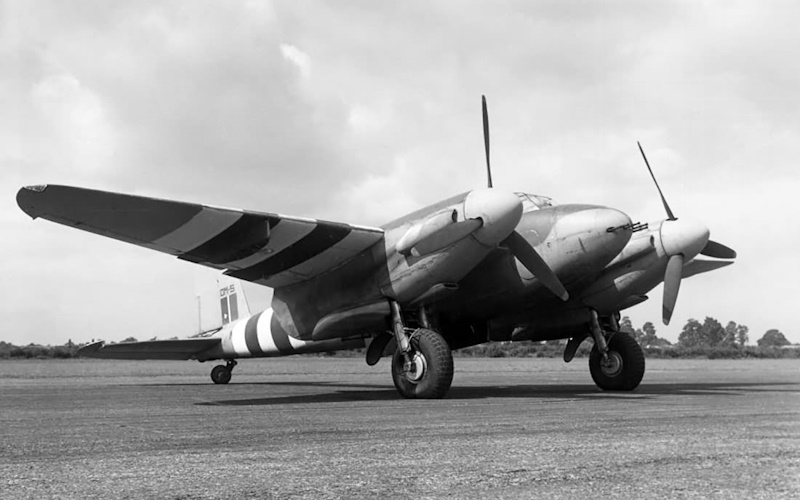
As mentioned, the FB.VI went into service in the spring of 1943, and was the most heavily produced Mosquito variant. The key to its popularity was its flexibility. FB.VIs were put to use performing "Intruder" sorties against specific enemy target areas; "Ranger" fighter sweeps to hit rolling stock and fighters on the ground; and "Instep" fighter patrols over the Bay of Biscay to take on Luftwaffe Junkers Ju 88 and Messerschmitt Bf 110 long-range fighters out to intercept RAF Coastal Command ocean patrol aircraft.
However, the FB.VI became most famous in service with the RAF "2nd Tactical Air Force (2TAF)", which was formed in June 1943, building up two "big wings" of FB.VIs, one at Sculthorpe and the other at Lasham. 2TAF was created after Bomber Command transferred their Mosquitos to the Pathfinder Force, and carried on the low-level precision strike missions devised by Bomber Command, beginning such attacks in October 1943.
2TAF Mosquitos focused on German targets sited in cities in Occupied Europe , where the RAF was understandably reluctant to perform imprecise high altitude attacks. Power stations were a favored target, but the FB.VIs took on other targets as well.
On 18 February 1944, 18 Mosquitos from Number 21, 464, and 481 Squadrons attacked the prison at Amiens, France, under Operation JERICHO. The objective was to "tumble down the walls" of the prison to allow condemned French Resistance fighters being held there to escape. The attack was successful, with about 250 prisoners managing to escape. However, about a hundred prisoners were killed in the raid, and a good number of those who escaped were quickly recaptured. The raid was led by RAF Group Captain Charles Pickard, whose Mosquito was shot down by Fw 190s during the action. He and his navigator are now at rest under a memorial in Amiens.
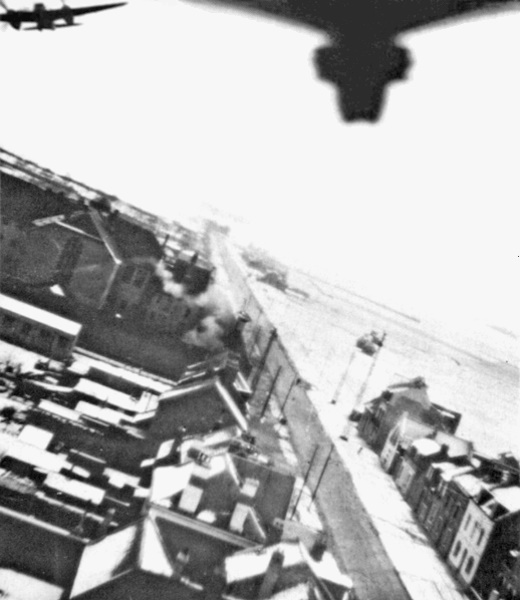
Now the Mosquitos turned their attention back to the Gestapo, engaging in what almost became a private war. On 11 April 1944, six FB.VIs of Number 613 Squadron struck Gestapo headquarters in The Hague, the Netherlands, destroying German records on the Dutch Resistance. Two bombs were tossed into the front door of the building.
On 31 October 1944, 18 FB.VIs hit a Gestapo office building at Aarhus University in Denmark. They came in so low that one Mosquito went back home with a piece of masonry in the fuselage. On 21 March 1945, Mosquitos hit Gestapo headquarters in the middle of Copenhagen. The mission was successful -- except that the strike leader's Mosquito clipped a bridge and slammed into an elementary school, with many civilian casualties.
In the meantime, Mosquito fighter-bombers were operating in support of the landings in France, striking German communications. The FB.VIs were also active in attacks on the launch sites for V-1 flying bombs in Northern France. The V-1s had been photographed at Peenemunde, and then on 28 November 1943 a PR Mosquito spotted the first French launch site. Both the RAF and the US Army Air Forces (USAAF) began to bomb the sites on 5 December 1943.
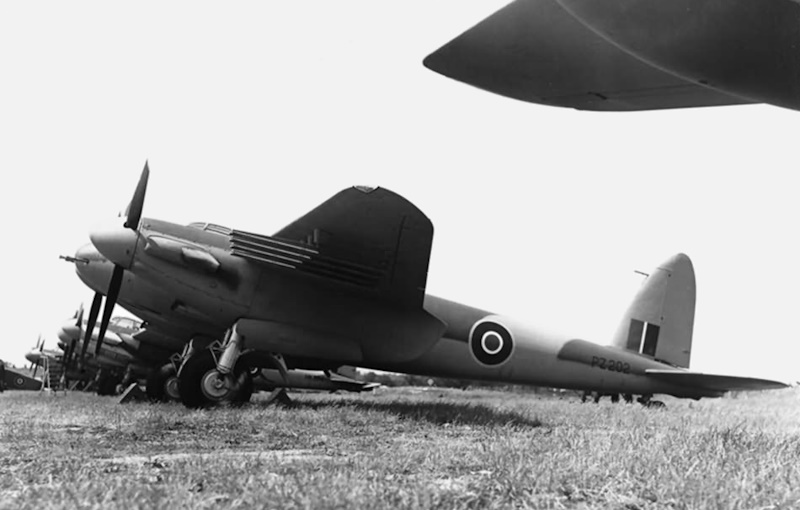
The campaign lasted into the fall of 1944. Statistics compiled later showed that the Mosquito destroyed one site for each 36.4 tonnes (40 tons) of bombs dropped, as opposed to 150 tonnes (165 tons) for USAAF Boeing B-17 Flying Fortresses, 158 tonnes (182 tons) for Martin B-26 Marauders, and 200 tonnes (219 tons) for North American B-25 Mitchells. However, the Germans were able to complete enough launch sites to fire off V-1s in quantity.
Apparently some FB.VIs were converted to a night-fighter configuration, with a small radome fitted with American ASH radar and Serrate radar homing gear to help harass German night fighters. Details of these machines are otherwise unclear.
* RAF Coastal Command did not get their hands on the Mosquito until June 1944, the beginning of the end of the Germans in France, and so their FB.VIs operated in the North Sea, with a Mosquito "Sea Strike Force" headquartered at Banff in Scotland to perform anti-shipping and anti-submarine strikes.
The "Banff Strike Wing" found the Mosquito even better at the job than the rugged and well-armed Bristol Beaufighters they had been using. The FB.XVIII and its Molins gun gave the Mosquito more punch, but was rendered obsolete when Coastal Command FB.VIs were qualified to fire rocket projectiles with solid metal warheads to punch holes in ships below the waterline. The Mosquitos also used depth charges with fuzes set to shallow depth to attack U-boats on the surface.
* One of the more unusual applications of the Mosquito was as a transport. These Mosquito transports were operated by BOAC for flights to neutral Sweden, since any commercial airliner that attempted such a flight would have been easily intercepted. The service began in early 1943 and continued through the war.
A single B.IV and nine FB.VIs were assigned to this duty. They carried mail, including diplomatic documents; high-value cargoes such as Swedish precision ball-bearings; and the occasional passenger tucked away in the bomb bay. The bomb bay was fitted with oxygen, a reading light, an intercom, and a bunk, and passengers were packed in wearing double flight suits, a life preserver, and a parachute. They were given reading material and refreshments to allow them to pass the time on the "ball-bearing" route. One of the most famous passengers was Danish physicist Niels Bohr, who was spirited out of Denmark to Sweden when the Nazis took full control of the country in 1943. Bohr had problems with his oxygen gear and passed out, but the pilot, failing to bring up his VIP passenger on the intercom, assumed as much and went down to low altitude.
BACK_TO_TOP* Although the Mosquito is identified with its wartime exploits, it remained in active RAF service for a decade after the end of the war. The T.III was extensively used for training, while combat machines remained in service with front-line units.
The FB.VI served with the British Air Forces of Occupation (BAFO) in Germany. The NF.30 and NF.36 remained first-line night fighters for British home defense until replacement by the de Havilland Vampire and Armstrong-Whitworth Meteor in that role in 1951.
The Mosquito PR.34 was the primary reconnaissance asset for the RAF until replaced by the English Electric Canberra in the early 1950s. In the early years of the Cold War, it was used for clandestine sorties over Eastern Europe and the USSR, and also saw combat during the insurgency in Malaya in the early 1950s.
The PR.34 set a number of records. A PR.34 of Number 540 Squadron set a record east-west transatlantic flight in September 1945, and in May 1944 one flew from London to Cape Town, South Africa, in 21 hours 31 minutes. The PR.34 also served in the Middle and Far East in the postwar period, and a PR.34A of Number 81 Squadron flew the Mosquito's last combat sortie over Malaya on 15 December 1955.
Bomber Command and BAFO kept the Mosquito B.35 in service until 1953. Some B.35s were converted to night photo-reconnaissance platforms as the PR.35 and remained in service for some time longer. 105 were converted in 1952 and 1953 by Brooklands Aviation to "TT.35" target tugs, with a target carried in the bomb bay and an air-driven winch attached below the fuselage. The TT.35s were operated by the Number 3 Civilian Anti-Aircraft Cooperation Unit at Exeter in the UK. The TT.35 was the last version of the Mosquito in formal RAF service, and was not phased completely out until 1961.
The Royal Navy also operated the Mosquito as a target tug, with 26 B.XVIs and PR.XVIs extensively modified by General Aircraft in 1950 to the "TT.39" configuration. The TT.39 was without argument the ugliest of all Mosquito variants; it was fitted with a glass cylindrical dome on the spine for the target winch operator, and had an extended "greenhouse" nose where a cameraman could film the action. The propellers had to be clipped to keep from striking the extended nose. The target winch was stowed in the bomb bay along with the target. The winch was driven by a ram-air turbine that could be extended out of the bomb bay. Apparently their operational life was short, with the type phased out by 1952, possibly because nobody could stand to look at it.
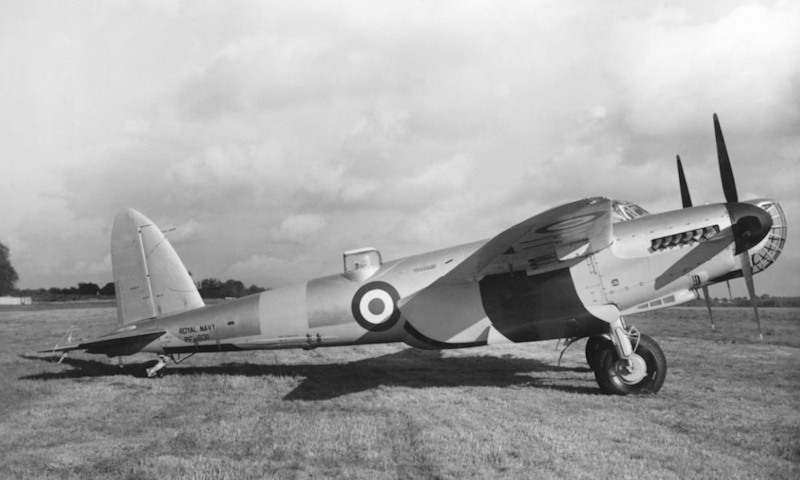
A number of different Mosquito variants were used for trials in the postwar period, for example evaluating rockets and other munitions. The Mosquito performed a "curtain call" in 1963, when five RAF TT.35s were dressed up as FB.VIs to perform in the movie 633 SQUADRON, starring Cliff Robertson and describing the adventures of a fictional squadron of the 2TAF. Three of these TT.35s were joined by a T.III in 1966 to participate in a sequel, MOSQUITO SQUADRON, starring David McCallum.
* In a sad note to the Mosquito's postwar accomplishments, Geoffrey de Havilland JR, who had been so intimately involved with the machine, was killed on 27 September 1946 when the "DH.108" experimental jet he was piloting lost its wings.
BACK_TO_TOP* Of course, the Mosquito saw extensive service with British Commonwealth forces, and Mosquitos were built in Canada and Australia.
The wheels began turning on Canadian production in July 1941, just as the first Mosquitos were being delivered to Number 1 PRU. The DH Canada plant at Downsview, in the Toronto area, was tooled up for the job. The first Canadian-built variant was the "B.VII", which was essentially a B.IV but with Merlins built under license by Packard, a Detroit engine manufacturer. Only 25 B.VIIs were built, all of which remained in North America.
They were followed by the similar "B.XX", which went into full production. The first B.XXs arrived in the UK in August 1943, and were in operational service by December. Most or all Canadian Mosquitos delivered to the UK were flown across the Atlantic, a hazardous flight on which aircraft occasionally disappeared without a trace. Early production was fitted with Packard Merlin 31 engines, while later production featured Packard Merlin 33s, with both engines providing 1,080 kW (1,450 HP) each. 245 B.XXs were built.
With the introduction of the two-stage Merlins, Canadian production then went to the "B.25", fitted with two-stage Packard Merlin 225s providing 1,210 kW (1,620 HP) each. A total of 343 B.25s was built, with 38 going to the RCAF, 70 to the Royal Navy, and the rest to the RAF.
The Canadians also built fighter-bomber Mosquitos derived from the FB.VI. The first was the "FB.21", which was almost identical to the FB.VI, the only distinction being Packard Merlin 31 engines, with 1,090 kW (1,460 HP) each. Only six FB.21s were built, with production quickly moving to the "FB.26", with minor improvements. A total of 337 FB.26s was built.
The Canadians also built a series of unarmed dual-control trainers. The first was the "T.22" trainer, which was based on the FB.VI and had single-stage Packard Merlin 33 engines. Only six were built, with the Canadians quickly moving to an improved derivative, the "T.27", with 49 built. They also converted 37 FB.26 fighter-bombers to a trainer designated the "T.29". The Canadians built a total of 1,034 Mosquitos, the majority of them going into RAF service.
* Australian Mosquito production was much more limited than Canadian production and is an untidy subject. The Australians focused on production of a FB.VI clone, the "FB.40", with 203 built, six more being converted before rollout to the "PR.40" specification. They were powered by Packard Merlins. Initial deliveries were in 1944.
Many of the FB.40s that were built were converted into other marks. 28 were converted to "PR.41s"; 22 were converted to "T.43s", which were dual-control trainers similar to the T.III with full armament, but featuring some Australian and US instruments; and one was converted to an "FB.42" prototype that went no further, and then became one of the conversions to PR.41s.
* The New Zealanders did not operate the Mosquito during the war, but obtained four T.43s and an FB.40 from Australia for training in 1946. Later on in that same year, the British provided four T.IIIs and eight FB.VIs (including 30 new-build fighter-bombers), though two crashed in Australia on the last leg of the ferry flight. Only a single squadron was formed, however, with most of the aircraft stored until they were all disposed of in 1953.
Another Commonwealth country, South Africa, operated Mosquito reconnaissance variants in the Mediterranean theater. After the war, the South Africans used their Mosquitos for aerial survey work.
* General Henry "Hap" Arnold, commander of the United States Army Air Forces, witnessed a demonstration of the Mosquito on 20 April 1941 as a guest of Lord Beaverbrook. Geoffrey de Havilland JR was in prime form that day, screaming the machine low over the ground and performing sharp maneuvers with one engine feathered. Arnold was extremely impressed, and returned to the US with engineering drawings of the machine.
There matters more or less stood with the Yanks until late 1942, when a B.IV Mosquito was handed over to Colonel Elliot Roosevelt, the American President's son and commander of a USAAF reconnaissance squadron in North Africa, equipped with Lockheed F-4 Lightning reconnaissance aircraft. The B.IV was faster and had much longer range than the Lockheeds, and Elliot Roosevelt began to press for adopting the British machine.
In the meantime, Mosquitos were finally beginning to roll off the production lines at de Havilland Canada in the Toronto area, and in December 1942 Geoffrey de Havilland JR brought one of the first Canadian Mosquitos down to Washington DC. Hap Arnold ordered that airport traffic be held off for a half hour to allow de Havilland to put on an aerial demonstration over the city. Geoffrey De Havilland then left for California to perform more demonstrations. He went by train in order to see the country, while the Mosquito went separately. In Los Angeles he met with his cousin, actress Olivia de Havilland.
Hap Arnold now became very determined to get his hands on the Mozzie, beginning with an offer to swap P-51 Mustangs for Mosquitos. The British turned him down. The Mosquito was increasingly seen as difficult to replace. Had Canada been producing Mosquitos in volume at the time, the Americans might have been able to get their hands on part of the production, but the Canadians were slow to ramp up, with only 90 Mosquitos built there in 1943. At least Arnold's persistent lobbying to get Mosquitos helped convince Bomber Command that they had something of value.
The Americans did manage to get their hands on a relatively small batch of Canadian aircraft. The US signed an agreement with the British government in October 1943 for 120 Canadian-built Mosquito bombers, but limited production meant that the US only got 5 B.VIIs and 35 B.XXs. They were converted to a reconnaissance configuration with US-built cameras, redesignated "F.8", and sent to the UK for service with the USAAF Eighth Air Force. The F.8's camera suite was minimal and the single-stage Merlins really didn't provide the performance the USAAF wanted, and so the F.8s were eventually replaced by PR.XVIs. The Americans obtained over a hundred PR.XVIs, along with a handful of T.IIIs for conversion or continuance training.
American pilots converting from their Lockheed F-4 and F-5 Lightnings, which had "handed" propellers, had to be trained to deal with the Mosquito's tendency to roll against the rotation of its propellers on take-off. There was a worse problem in that over-anxious fighter pilots tended to mistake Mosquitos for Messerschmitt Me 410s, which in fact did have a similar configuration -- and so the USAAF gave their PR.XVIs red-painted tails as a recognition aid.
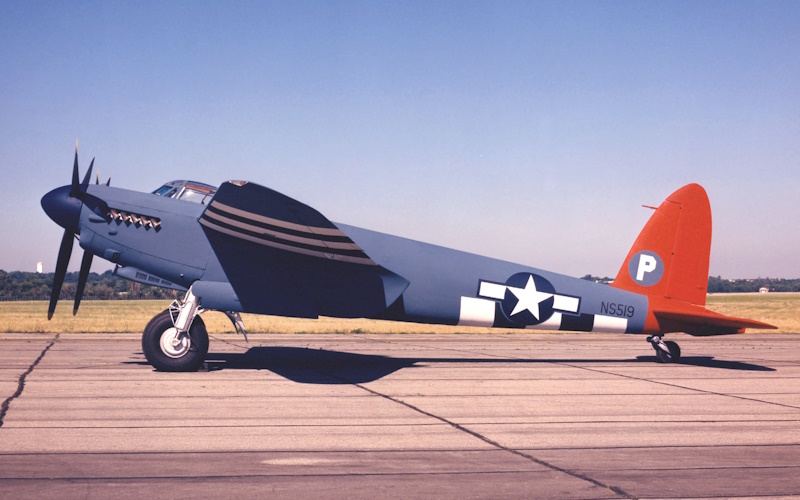
The majority of the Yank PR.XVIs were used in their intended photo-reconnaissance role, but a good number of them were used for weather reconnaissance, and they were also modified for special tasks. Some were fitted with US-built "H2X" targeting radar, the American three-centimeter counterpart to the British ten-centimeter H2S, mounted in the nose radome. Since American crews referred to H2X as "Mickey" for some forgotten reason -- one suggestion was that it was called "Mickey Mouse" because of severe early teething problems -- these were known as "Mickey Ships". Some USAAF Mosquitos were fitted out for dispensing chaff, and seven were fitted with communications gear to support Allied agents and resistance forces in Occupied Europe.
USAAF Mosquitos were also fitted to use the LORAN navigation system, the American answer to Gee, and since LORAN was something of an Allied standard later in the war it is plausible that some RAF Mosquitos had LORAN receivers as well. Some sources also mention that the USAAF operated a squadron of NF.30s in Italy late in the war, but details are unclear. The USAAF returned all their Mosquitos at the end of the war, as part of the reverse Lend-Lease agreement.
* A number of nations obtained hand-me-down Mosquitos from various sources:
* A number of Mosquitos were operated by civilian organizations after the war. A company from Los Angeles, Jack Amman Photographic Engineers, bought a number of PR.34s. These machines were converted by DH at Hatfield for survey work in Libya. Spartan Air Services in Canada obtained a number of B.35s and also converted them for survey work, the last of the batch surviving in operation until 1963. The Spartan machines had a number of modifications, in particular a forward-hinging canopy.
Although a few Mosquitos were bought up for use as air racers, most of those available for sale had single-stage engines and flat fighter windscreens and didn't have the performance to meet the competition.
While many Mosquitos remain on static display, only a few remain airworthy. One of the drawbacks of its wooden construction was that the Mosquito hasn't aged as gracefully as all-metal aircraft. That should not be interpreted as a criticism of the DH engineering team, since none of them would have expected any Mosquitos to be flying in the 21st century.
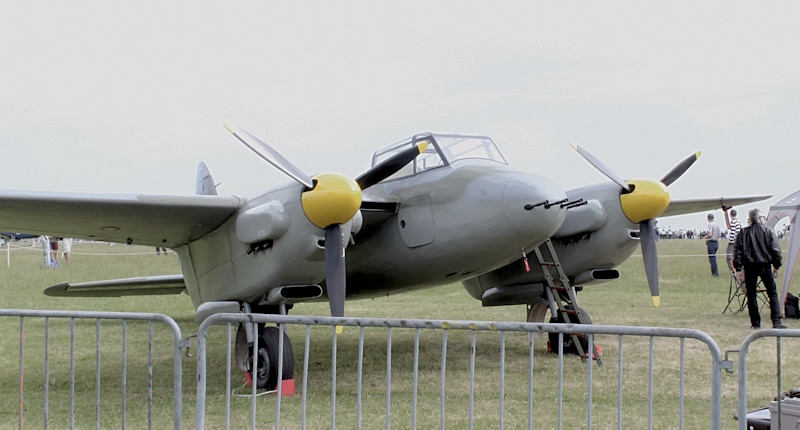
A group of French air enthusiasts, the "Reconstruction Repliques Avions Anciens", did build a 3/4ths-scale flying replica of the Mosquito, powered by twin Continental flat-six air-cooled engines; it performed its initial flight in 2011. It was a brilliant job, the only jarring element being the necessarily oversized canopy. Unfortunately, it was badly damaged in a landing accident in 2015, and it is not clear if it ever returned to flight.
BACK_TO_TOP